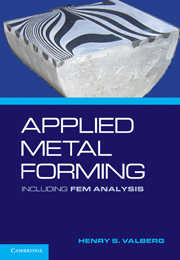Book contents
- Frontmatter
- Contents
- Preface
- APPLIED METAL FORMING
- 1 Characteristics of Metal Forming
- 2 Important Metal Forming Processes
- 3 FEA of Metal Forming
- 4 Theory
- 5 Reduction and Proportions of the Plastic Zone
- 6 Deformations from the Velocity Field
- 7 Technological Tests and Physical Simulation
- 8 Flow Stress Data
- 9 Formability and Workability
- 10 Friction and Friction Models
- 11 Thermal Effects
- 12 Experimental Metal Flow Analysis
- 13 Theoretical Methods of Analysis
- 14 Finite Element Analysis
- 15 FEA of Technological Tests
- 16 Forging
- 17 FEA of Forging
- 18 Extrusion
- 19 FEA of Extrusion
- 20 Rolling
- 21 FEA of Rolling
- 22 Drawing of Wire, Profiles, and Tubes
- 23 FEA of Wiredrawing
- 24 Sheet-Metal Forming
- Index
6 - Deformations from the Velocity Field
Published online by Cambridge University Press: 05 June 2012
- Frontmatter
- Contents
- Preface
- APPLIED METAL FORMING
- 1 Characteristics of Metal Forming
- 2 Important Metal Forming Processes
- 3 FEA of Metal Forming
- 4 Theory
- 5 Reduction and Proportions of the Plastic Zone
- 6 Deformations from the Velocity Field
- 7 Technological Tests and Physical Simulation
- 8 Flow Stress Data
- 9 Formability and Workability
- 10 Friction and Friction Models
- 11 Thermal Effects
- 12 Experimental Metal Flow Analysis
- 13 Theoretical Methods of Analysis
- 14 Finite Element Analysis
- 15 FEA of Technological Tests
- 16 Forging
- 17 FEA of Forging
- 18 Extrusion
- 19 FEA of Extrusion
- 20 Rolling
- 21 FEA of Rolling
- 22 Drawing of Wire, Profiles, and Tubes
- 23 FEA of Wiredrawing
- 24 Sheet-Metal Forming
- Index
Summary
It may be useful to know the velocity field for a metal forming process, as will be shown in the forthcoming sections. If the velocity field is known, a number of deformation parameters can, in principle, be deduced from it. This is realized if one considers the definitions of the different strain and strain-rate components in Sec. 4.2.1 and Sec. 4.3.3.
Let us first explain what is meant by a velocity field. The term refers to the distribution of velocities, at a given moment of forming, within a workpiece, and the evolution of them with time, from beginning to end of the forming process.
The usefulness of determining the velocity will first be shown for the simple case of homogeneous slab compression. It will be shown how a simple velocity field can be determined, which gives an adequate description of the overall deformational behavior of the slab. Then it will be shown how different strain and strain-rate components can be deduced from this velocity field. In the last problem at the end of this chapter, a complex velocity field that incorporates the effect of bulging in cylinder compression, is dealt with.
Stationary and Nonstationary Velocity Fields
Metal forming processes are commonly classified in two groups, stationary processes and nonstationary processes, dependent on whether there is a constant velocity field or the field changes with time throughout the forming operation.
- Type
- Chapter
- Information
- Applied Metal FormingIncluding FEM Analysis, pp. 84 - 91Publisher: Cambridge University PressPrint publication year: 2010



